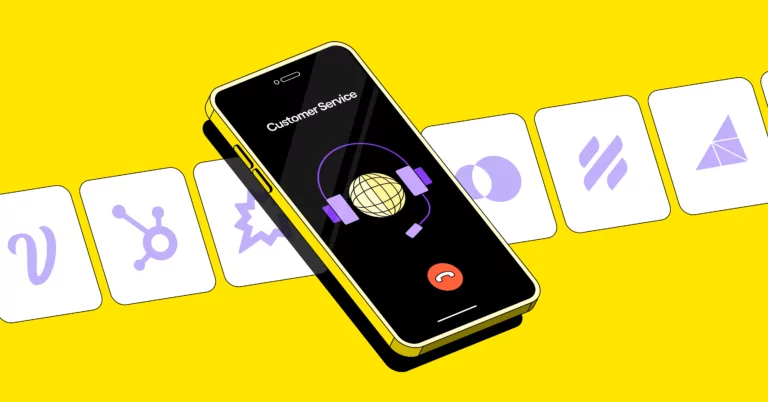Are you looking for a customer service tool to rule them all? The platform that will magically make your customer service operations run on autopilot? That will even create and close your tickets out for you?
We’re here to tell you that it doesn’t exist.
Because a perfect tool isn’t something you can find.
But a perfect toolbox is absolutely within reach.
In this article, we share which customer service software categories matter for small businesses. We also list our top picks (along with prices, features, and limitations) so you can make an informed decision.
Our customer service software picks
There are four essential customer service software categories for small businesses: help desk software, customer communication software, chatbot software, and training and quality assurance (QA) software. Each of these categories should have a place in your toolbox.
Our recommendations for the tools you should pick are:
Help desk software
- Our pick: HubSpot Service Hub
- Runner-up for inbox-focused teams: Front
- Runner-up for ecommerce teams: Gorgias
Customer communication software
- Our pick: OpenPhone
- Runner-up: HelpScout
Chatbot software
- Our pick: Voiceflow
- Runner-up: Tidio
Training and QA tools
- WorkRamp
- Notion
- Gong
- Klaus
- Notifier
Scroll down to find out why we chose them and how they can help you run your customer service operations.
Essential customer service software categories
The following types of customer service software make getting your support program up and running easy. They can also help your business scale as your ticket volume and team size grows.
Let’s start with the most foundational support tools:
Help desk software
Help desk software is the cornerstone of any customer service organization. These platforms help you centralize customer support requests from all your support channels — email, social media, chatbots, and more — into a single platform. This makes it easy for teams to manage customer interactions and respond to inquiries more efficiently.
The best help desk software comes with automation features like ticket routing and response templates, which can streamline the support process, reduce response times, and maintain a high level of service quality for customers.
Help desk tools also support managers and supervisors by measuring your support team’s performance. This way, you can highlight high performers on the team, provide training to team members who need it, and make sure everyone is on the same page.
Customer communication software
Help desk tools are excellent for sending emails to customers, but they rarely provide all the calling and texting features most small businesses need. Customer communication software fills this gap — these tools manage phone and text communications between your customer service team and customers.
The best customer communication tools offer unlimited calling and texting to US and Canadian numbers, typically through a WiFi connection so you can make calls from anywhere. They can also integrate with help desk tools so businesses can tap into the best of both worlds.
Chatbot software
With recent developments in generative artificial intelligence (AI) and large language models (LLMs), it’s easier than ever to leverage AI chatbots in a customer service context. They can provide instant answers with little to no response time and create self-service pathways that make it easier to manage a large influx of customers.
Website chatbots can even free up your support team to chat with customers who need special assistance. Their ease of setup with no-code tools makes them an essential part of today’s customer service tool stack.
Training and QA software
This software category focuses on upskilling your team and maintaining customer service standards to ensure high CSAT and NPS scores.
It isn’t essential for a one to two-person team, but it’s an absolute necessity if you’re growing your customer service department.
No one tool covers all training and QA needs, so we’ve shared a few recommendations at the bottom of this guide.
When should a small business invest in customer service tools?
Your small business is likely ready to invest in customer service tools when:
- Customer requests come in from multiple channels: Hearing from customers over email, social media, and your office phone? Maybe you need one place to manage all your customer conversations, which is when you should invest in customer service tools.
- You can’t manage the inquiry volume as is — even if you hire more: As your customer base grows, so will the volume of your inquiries and support requests. If your team is struggling to keep up, it’s time to consider a tool that can help manage and organize these interactions efficiently.
- Your team is bogged down in administrative tasks: If your team spends a lot of time responding to customers and completing repetitive tasks like manually tagging tickets using email and spreadsheet tools, it might be time to invest in customer service tools to make them more efficient.
Remember that you shouldn’t make this decision alone (unless you’re a solopreneur, of course). It’s a good idea to chat with members of your team about options or discuss possible bottlenecks.
Now, let’s dive into the software you need most — starting with help desk tools.
The 3 best help desk software tools for small businesses
Choosing a help desk software might seem like a lot of pressure for you because of how important it is to your customer service team’s success. Our three tool picks will set you up for success and remove that pressure.
Our top pick is a help desk that has all the features your team needs, integrates with the rest of your tool stack, and grows with you. Our runner-up options are uniquely suited to niche business needs, specifically for e-commerce businesses and businesses that only offer email support.
Let’s start with the best option offering a free plan:
1. Our top pick: HubSpot Service Hub
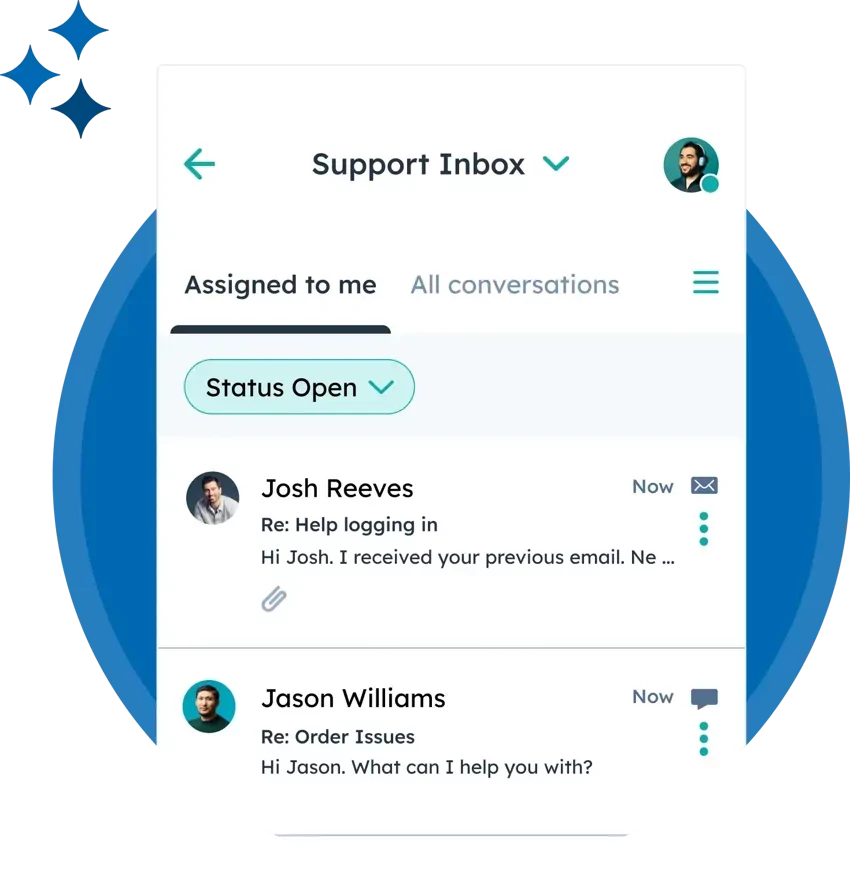
If you want a help desk platform that can scale with your team, HubSpot Service Hub is the way to go. This help desk software tool manages the full gamut of customer touchpoints, whether they originate in the HubSpot ecosystem or inside another platform.
With HubSpot Service Hub, businesses get access to conversational tools, a shared inbox, help desk automation, knowledge base functionality, customer feedback and custom surveys, reporting, a customer portal, playbooks, and more. It can also help you create a single source of customer information so support agents don’t spend half the day searching for context.
Looking for ways to call and text your customers, too? This is less of a feature with the HubSpot Service Hub. Although it does offer some limited calling capabilities, their Starter plan caps calls at 500 minutes per month, and their Professional plan caps calls at 3,000 minutes per month.
A better alternative is to use a HubSpot phone integration like OpenPhone so you can make unlimited calls and log them directly into your HubSpot account.
HubSpot Service Hub features
- Contact management
- Ticketing
- Live chat
- Team email
- Tickets closed reports
- Workflow automations
HubSpot Service Hub pricing
If you’re browsing HubSpot’s website, you may see dozens of other plans depending on different use cases, such as sales. The plan pricing below covers their helpdesk solution:

- Free: $0 per month for access to contact management, ticketing, live chat, team email, tickets closed reports, and more
- Starter: $18 per month for two user seats and access to live chat, meeting scheduling, simple ticket automation, conversation routing, and more
- Professional: $450 per month for five user seats and access to playbooks, customer feedback surveys, customer portal, service analytics, and more
- Enterprise: $1,200 per month for 10 user seats and access to single sign-on, conversation intelligence, and more
2. Runner-up for inbox-focused teams: Front
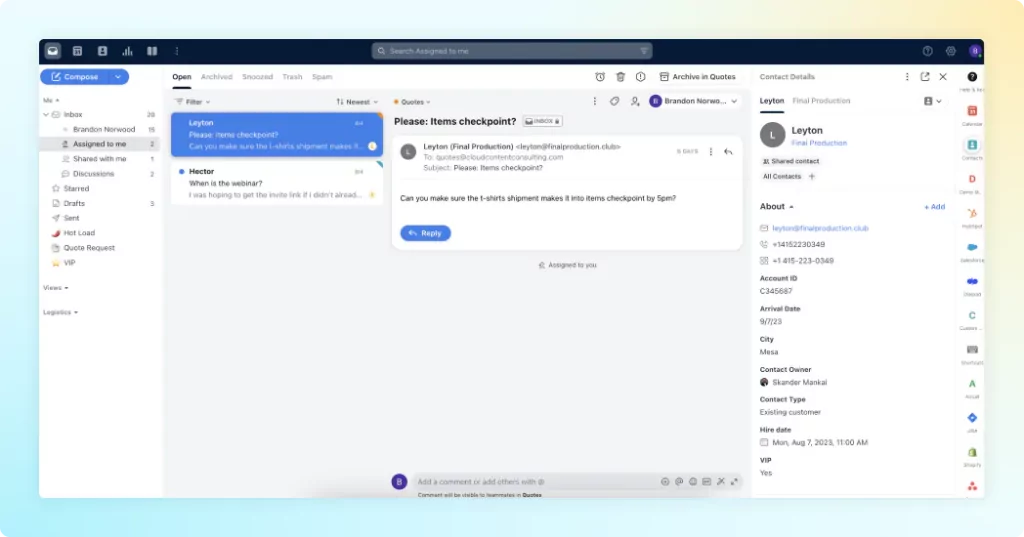
If you’re comfortable keeping your small business small, Front’s lightweight help desk tool may be what you’re looking for. This customer service platform sits on top of your inbox so the learning curve is relatively low.
With Front, you can centralize your customer messages from any channel into a single, navigable dashboard. This can help you tap into automated workflows, work on efficient team collaboration, and gather insightful analytics. If you’re just starting with customer service operations, this is a quick and easy option.
Front is both lightweight and powerful, so you can begin to manage customer queries instantly. While established players like HubSpot take a while to set up and navigate, Front can help you hit the ground running in a few days or less.
You can even test Front with a free trial to see if it’s right for you.
Front features
- Omnichannel shared inboxes
- Team collaboration on customer messages
- Included knowledge base and website live chat
- Access to 3rd-party integrations
Front pricing
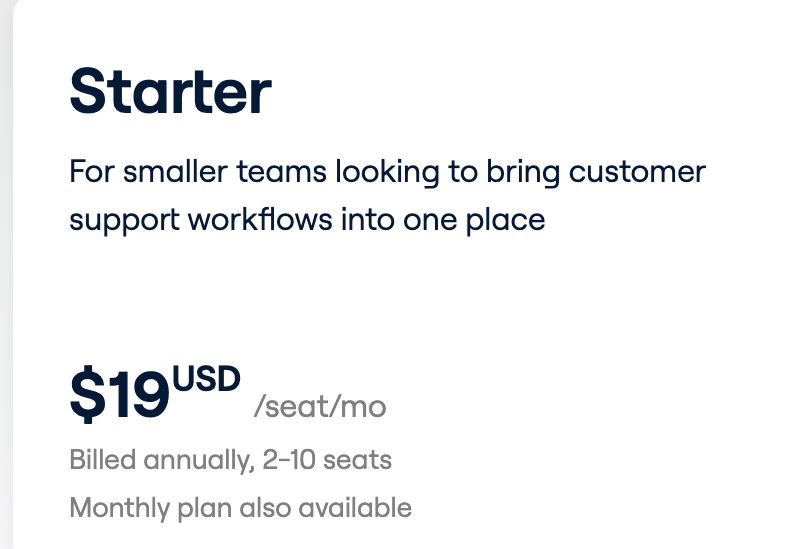
Front offers an entry-level plan for small businesses priced at $19 per seat per month (billed annually). It offers all the essential features you need, including omnichannel communications, collaborative inboxes, round-robin assignment, customizable chat widget, a basic knowledge base, and software integrations.
3. Runner-up for e-commerce teams: Gorgias
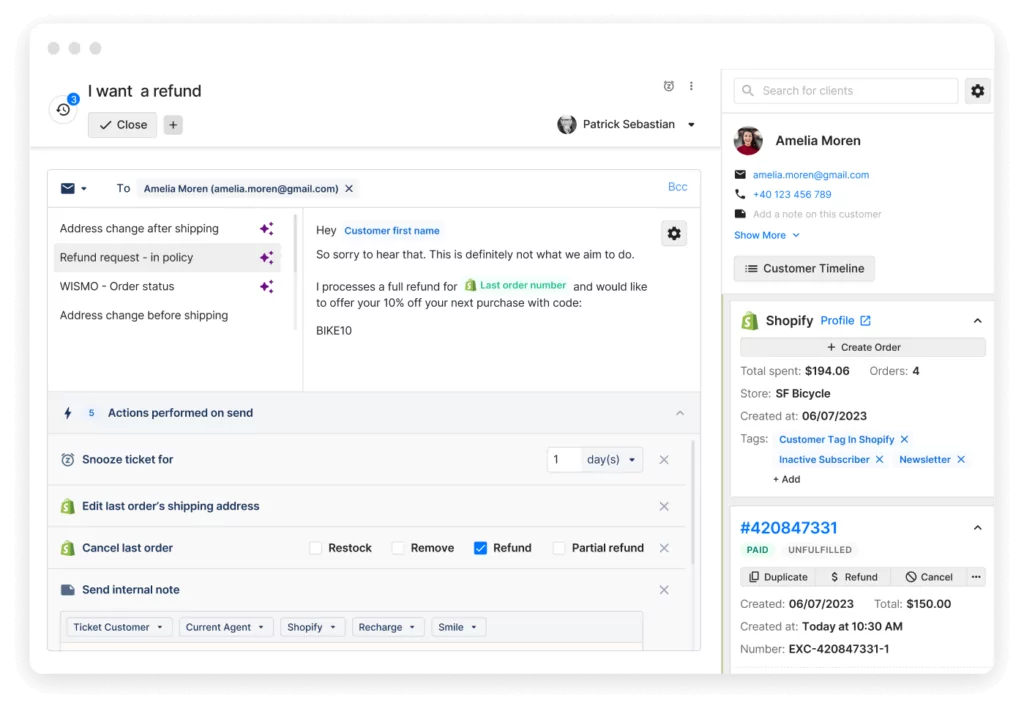
If you’re running an e-commerce business, Gorgias should be your help desk platform. It integrates with all the major ecommerce platforms — Shopify, BigCommerce, WooCommerce, and Magento — so you don’t have to switch between tabs to get the full context.
Gorgias also offers AI-enabled ticket management to route queries to agents based on customer needs. Plenty of other automations save you time, especially when it comes to cutting down repetitive admin work.
One more thing that sets Gorgias apart: its unique pricing model. While most help desk tools offer seat-based pricing, Gorgias offers ticket-based pricing, which means you only pay for what you use.
There are still a few drawbacks to keep in mind, including Gorgias’s overpriced phone and SMS features. Calling and messaging costs $50 per month — they don’t come standard on any plan. You’re better off paying for a dedicated customer communication tool (keep reading as we cover the top tools).
Gorgias features
- E-commerce platform integrations
- Omnichannel interactions, including social media channels
- Integrations with other e-commerce tools like Klaviyo, Yotpo, Recharge and Postscript
- Workflow automations
- Analytics
Gorgias pricing
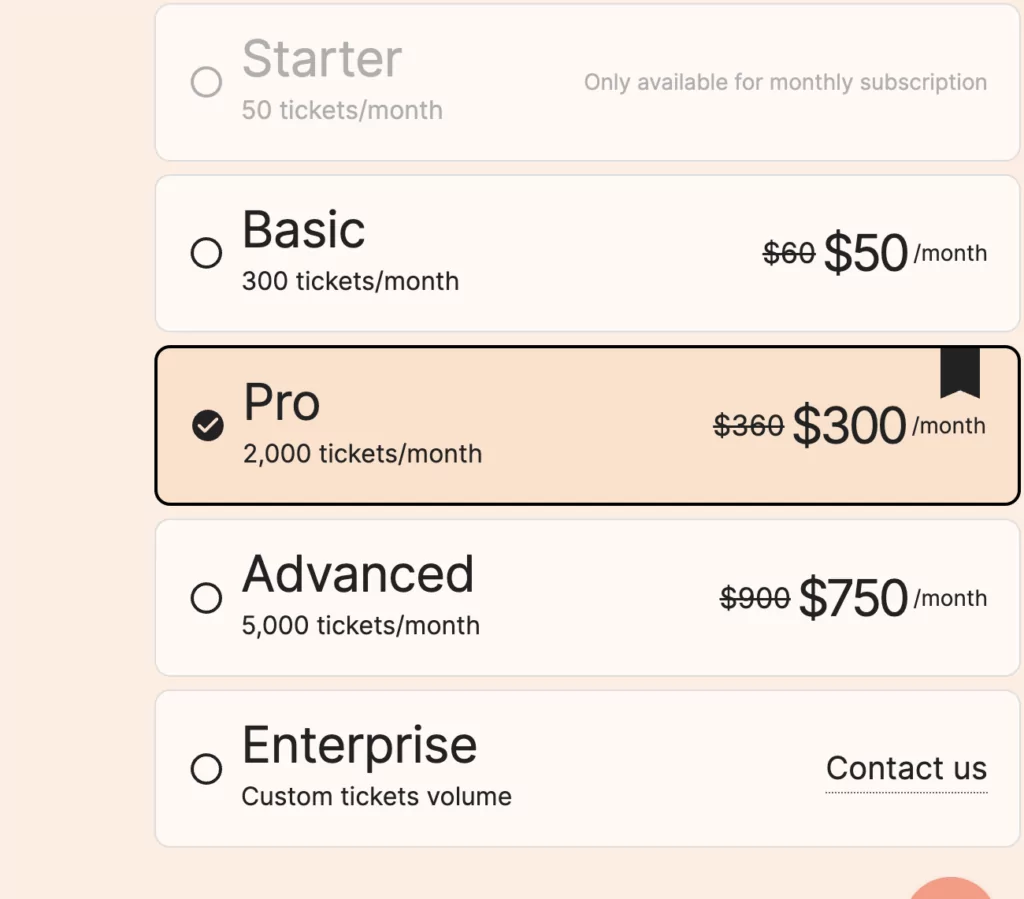
Gorgias’ Help Desk product offers ticket-based pricing through four plans:
- Basic: $50 per month for 300 monthly tickets with Shopify, BigCommerce, and WooCommerce integrations, workflow automations, and support performance statistics
- Pro: $300 per month for 2,000 monthly tickets to access integration with Magento and revenue statistics
- Advanced: $750 per month for 5,000 monthly tickets to access a dedicated success manager and a full onboarding experience
- Enterprise: Custom pricing for custom ticket volume
Gorgias also offers a basic Starter plan for 50 tickets a month that’s $10 per month (billed monthly). It offers all the features of the Basic plan but only comes with three user seats and no BigCommerce integration.
On top of all this, Gorgias offers a few different add-ons:
- Automate: $30 per month for monthly automated interactions like autoresponders, flows, quick responses, and order management
- Convert: $30 per month for on-site campaigns, retargeting, discount codes, audience segmentation, and more
- Voice: $30 per month for phone conversations
- SMS: $20 per month for SMS tickets

How to choose the right help desk software for your business
It’s easy to get lost in the world of help desk software as a small business.
So, what are the essential categories you should consider?
You should start with:
1. Features
Good help desk software can help you manage support tickets, but great help desk software makes it easier to deliver delight. You need to find a tool that benefits both customers and support agents. Remember: if your help desk software doesn’t have clear benefits for your team and ends up being time consuming to use, they may not consistently complete administrative work like ticket tagging and categorization.
It’s a good idea to prioritize platforms that offer a complete help desk solution. Ask yourself: what does your team need to offer better support? Can you anticipate future needs and be proactive about picking a compatible platform that will serve your business years from now?
A few essential help desk software features include:
- Ticketing system to manage support requests
- Knowledge bases for self-serve support and rep-managed support
- Workflow automations to efficiently manage support requests
- Integrations to share data and perform tasks outside the help desk
- Reporting to evaluate performance
2. Pricing
Cost isn’t everything when you’re buying a help desk tool. But your ROI still matters.
First, do the math and see if a tool’s price fits your budget. Are you comfortable going a little over the limit? Could you get a different or more cost-effective plan?
Next, do a cost analysis based on the pricing models of different tools. Most tools rely on seat-based pricing, but some tools (like Gorgias) use ticket-based pricing. For your team size, which plan offers the best bang for your buck?
Keep in mind you shouldn’t necessarily aim for the lowest dollar amount. The better option is to look for the greatest value — such as the workflows or the amount of time you unlock based on the cost you pay.
3. Reviews
Some help desk tools offer demos and free trials, but they can’t (and shouldn’t) replace customer reviews. Reviews offer candid insights and honest opinions from other small business owners who may be in a similar position. They also highlight important quality-of-life issues and potential limitations that may affect your team.
Check customer reviews for each tool on your shortlist and look for red flags you may not have considered. Remember, the platform should be easy to use, simple to learn, and come with high-quality support in case you run into trouble.
Can’t find the answers you’re looking for? It never hurts to post on a public forum to cover your bases.
The 2 best customer communication software tools for small businesses
The more you centralize your customer communication system, the easier it will be to grow your business.
There are dozens of platforms available to choose from, so we’re only pointing out the cream of the crop here.
Let’s start with the highest-rated option:
1. Our pick: OpenPhone
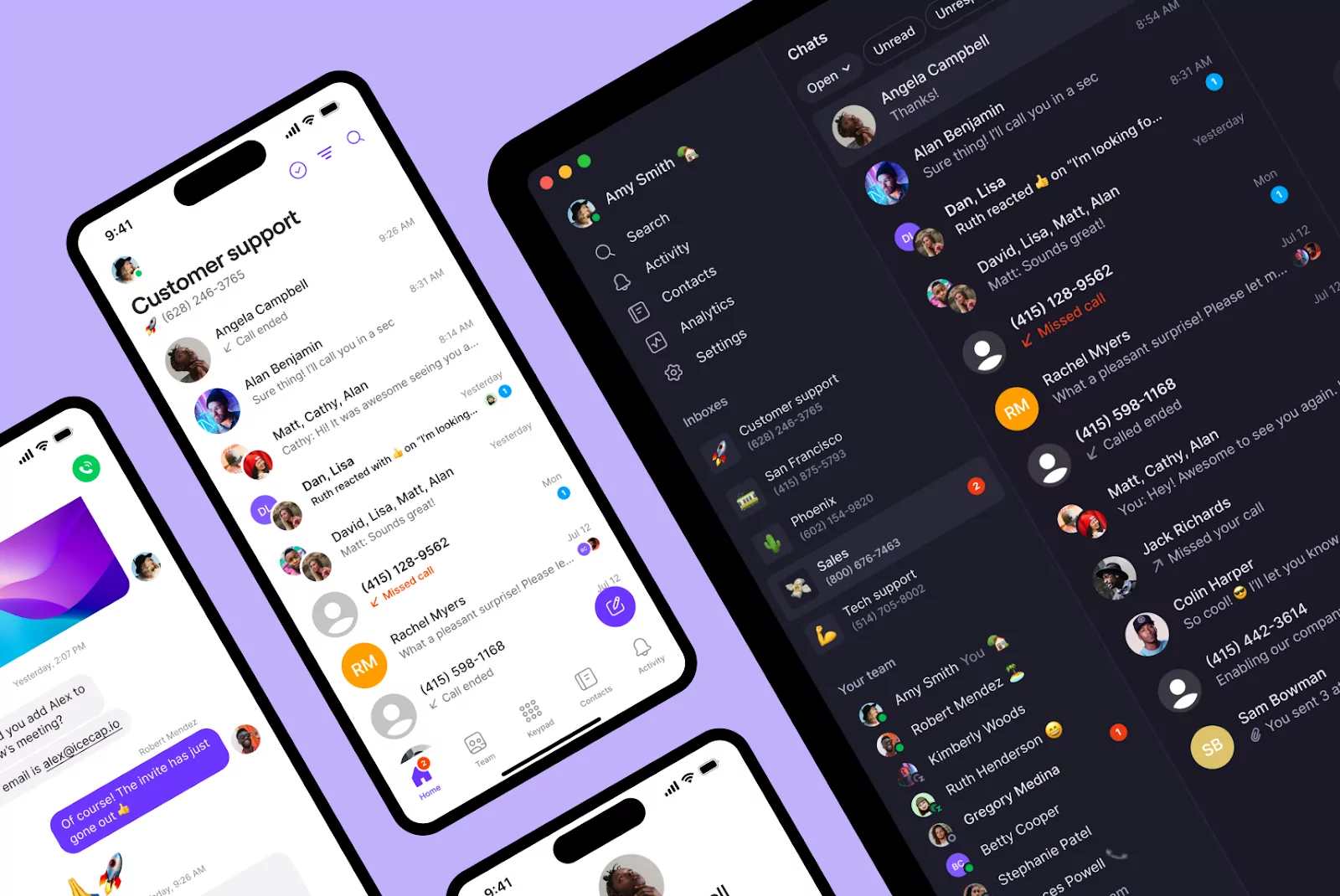
Yes, we’re biased, but for good reason. OpenPhone is the best customer communication software for small businesses and startups. Not only do we offer unlimited calling and texting in the US and Canada, but we also run on Voice over Internet Protocol (VoIP) technology — which means you can work from anywhere with a WiFi connection.
With OpenPhone, you can choose your own local and toll-free numbers, as well as preferred area codes so customers recognize your number. Then, you can set up shared numbers with your team, which makes it easy to split responsibility for incoming calls and messages.
OpenPhone offers a whole host of ways to help you more effectively communicate with customers and take more work off your team’s plate. For example, you can tap into:
- OpenPhone’s Zapier integration to automate specific workflows such as sending appointment confirmation texts
- AI call summaries and transcriptions, which means your customer service agents never have to take notes again
- Auto-replies, snippets, and AI-generated message responses so you can reduce message response times and save time on repetitive tasks
- Internal threads, shared inboxes, and conversation tagging to keep everyone on your team aligned
For all these reasons and many more, OpenPhone is the #1 business phone solution as rated by G2.
No need to take our word for it, though — you can try us free for seven days.
OpenPhone pricing
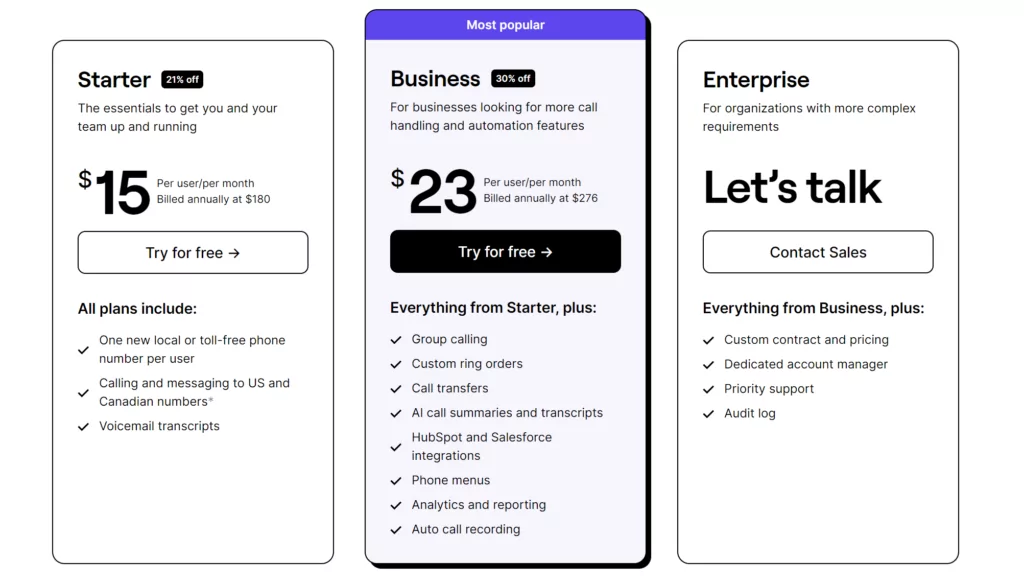
- Starter: $15 per user per month to access voicemail transcripts, unlimited calls and texts in the US and Canada, one new number per user on your account, and more
- Business: $23 per user per month to access phone menus (IVR), call transfers, analytics, CRM integrations, and more
- Enterprise: Contact us for more information
2. Runner-up for teams that need desk phones: RingCentral
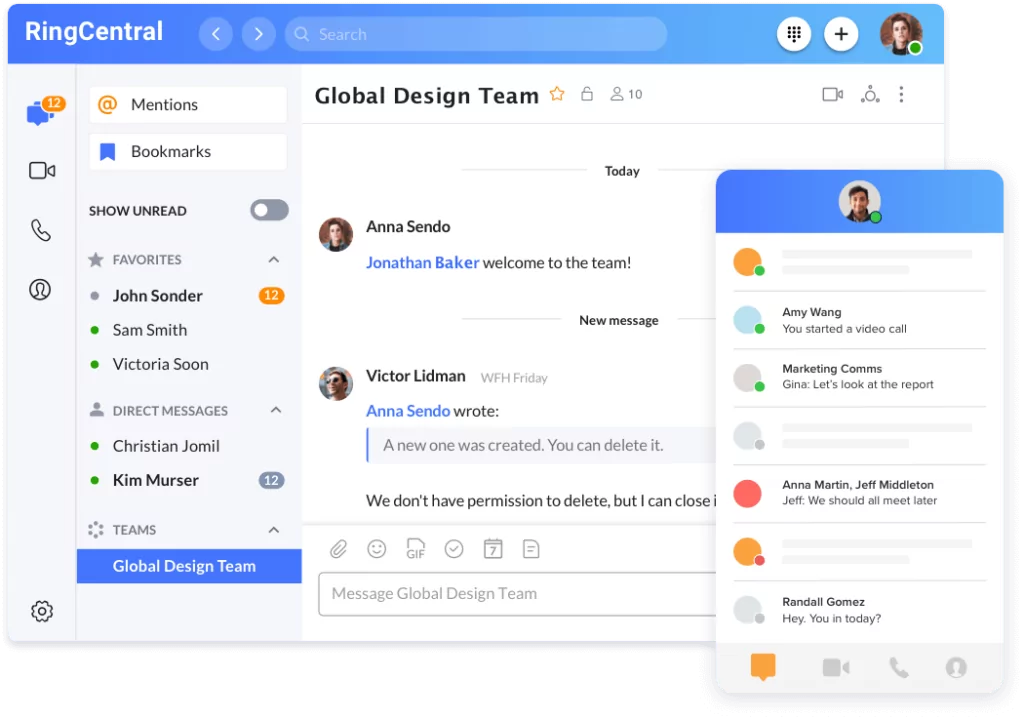
Remote work is a popular option for growing teams, but many businesses still prefer to work out of an office. If that’s your preference, you might prefer a business phone that offers desk phone rentals for your team. In this case, RingCentral may work well for you.
RingCentral is a customer communications software provider that has been serving small businesses since 1999. It offers free unlimited calls in the US and Canada, call recording, multi-level auto attendants, and even video meetings.
But while RingCentral is a decent option for customer communications, it’s a runner-up in our list for two key reasons.
- Texting limits: RingCentral does offer SMS and MMS messaging, but it limits the number of texts you can send on each of its plans. The Core plan only offers 25 texts per user per month before you have to buy more credits or upgrade to a more expensive plan.
- Storage limits: RingCentral limits the amount of storage you can use to save customer conversations. Each user can only save 5,000 text messages, so over time, it could be tricky to get the context you need. Similarly, RingCentral limits call recordings to 90 days in an account, with up to 100,000 recordings per account.
If these are deal breakers for your business, you may want to look for another business phone alternative.
RingCentral pricing

RingCentral offers three pricing tiers to businesses:
- Core: $20 per user per month, includes messaging and phone services
- Advanced: $25 per user per monthunlocks texting, calling, and on-demand call recording
- Ultra: $35 per user per month unlocks access to messages, phone calls, videos, automatic call recording, and an open API
For more advanced features, RingCentral also has contact center-specific plans. You must contact them, though, to receive a quote.
How to choose the right customer communications software for your business
If you ask any small business owner what would happen to their business if their business phone stopped working, they would tell you their company would implode overnight.
Beyond uptime, here are major factors you should keep in mind when selecting your customer communications tool.
1. Prioritize essential features
Getting more features isn’t always better, especially if you’re not using them. Why pay for 30 features if you’re only using 15? It’s a good idea to check for bloat before signing on the dotted line.
Every small business communications tool should offer features like:
- Unlimited calling and texting in the US and Canada so your team isn’t limited by call and message limits as you grow
- A web, desktop, and mobile app so you can get work done on any device
- Team collaboration features like shared numbers, internal threads, and tagging so your team can share support responsibility and stay aligned when communicating with customers
- Business phone features like phone menus, auto-replies, snippets, and ring order so your team can deliver a professional experience
- Integrations with your help desk and your CRM (like HubSpot or Salesforce) so you don’t lose track of customer relationships
You may need other features depending on your use case, like SLA agreements or real-time transcriptions. It may be worthwhile to chat with a sales representative to see if any upcoming features align with your business’s needs.
2. Estimate value for money
We know time is money, and the ultimate goal of adopting communication software is to save more of both. If a communications tool doesn’t meet this criteria, it shouldn’t be on your list.
But how do you estimate each platform’s value for your money?
Here’s the simple math:
- Look at the features available with each tool’s plans. For example, does the platform offer unlimited calling and texting, or is it gated so you eventually have to upgrade?
- Consider the features you use. If you’re paying for desk phone paging or online faxing, for example, are you truly getting your money’s worth?
- Calculate the time cost of using a specific platform. How much will it cost you to scale over time? How steep is the learning curve to use a specific solution? Is it going to be expensive to add or onboard new users?
Again, don’t get stuck looking for the lowest-cost plan. Picking a bare-bones platform just to save money may end up slowing your growth in the future. It’s far more efficient to look at overall value and partner with a platform you can scale with as time goes on.
3. Refine your search with reviews
Customer communication tools, especially the ones that use VoIP technology, offer highly variable experiences. Even if a tool offers everything you’re looking for, its learning curve, interface, or reliability may miss the mark.
To assess a communication platform for potential problems, you should read customer reviews on all major third-party sites (think G2, Trustpilot, TrustRadius, and others). Then, you can sort by keywords or star ratings to look for recurring themes.
Keep an eye out for issues with:
- Ease of use
- Quality of support
- Historic uptime
- Compliance and security
The 2 best chatbot software options for small businesses
It’s hard to argue with the benefits of a chatbot — they’re one of the best communication channels for handling commonly asked questions.
Here are two providers that offer live chat software you can use to grow your business.
1. Our pick: Voiceflow
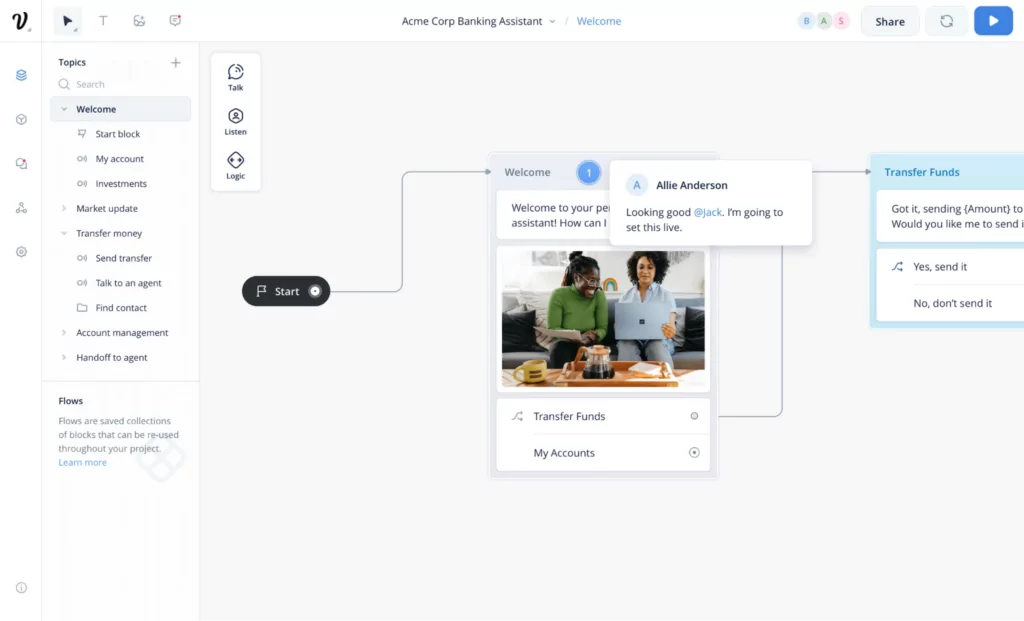
Voiceflow is an AI chatbot builder that allows you to fully customize your chatbot’s capabilities. You can build chatbot flows in a visual no-code builder, use whichever AI model you prefer, and integrate it across the rest of your tool stack.
If you don’t have time to build your own AI chatbot, you can use one of Voiceflow’s templates to get started. For example, here’s a template that offers a complete support bot so you can answer FAQs and capture customer data.
If you’re just looking for a no-code tool to quickly train and launch your own custom chatbot, Voiceflow is an excellent option.
Voiceflow pricing

- Sandbox: Free for a single editor, 50 knowledge base sources, two agents, and 100k monthly AI tokens
- Professional: $50 per month for 200 knowledge base sources per agent, 20 agents, 1M monthly AI tokens, and more
- Teams: $500 per month for 1,000 knowledge base sources per agent, unlimited agents, 10M monthly AI tokens, and more
- Enterprise: Custom pricing for unlimited knowledge base sources, unlimited editors, SSO, and more
2. Runner-up: Tidio
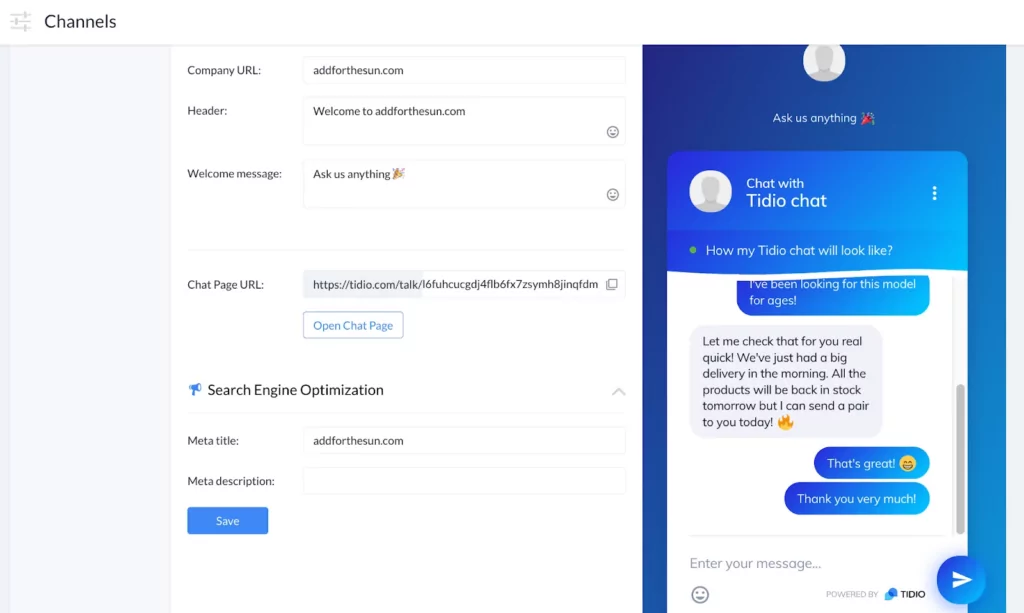
Looking to build self-service portals? Tidio’s platform is what you’re looking for.
Whenever a customer submits an inquiry, Tidio’s proprietary AI (called Lyro) crawls through your support content to offer personalized answers. This allows your team to focus on other tasks — Tidio’s AI answers roughly 70% of customer inquiries.
Lyro offers a more involved workflow for answering complex questions. First, Tidio’s Reply Assistant feature allows customer service reps to respond with basic answers. Then, Lyro AI turns them into fully fleshed-out responses so agents don’t have to type an entire block of text.
Another thing to keep in mind: Lyro integrates with your help desk. If you’re using Zoho Desk, Zendesk, Freshdesk, or Intercom, you don’t have to add an extra standalone tool to your tech stack.
The biggest limitation of using Tidio? The number of conversations you can have per month. If you expect website users to initiate more than 200 conversations in a month, you could end up spending $499 per month.
Tidio pricing

- Free: $0 per month for 50 free Lyro conversations
- Lyro AI: $39 per month for up to 200 Lyro conversations
- Tidio+: $499 per month for a custom Lyro conversation limit
How to pick the right chatbot software for your business
With the hype around AI tools today, how can you be sure which chatbot software to use and which ones to avoid?
Here’s how:
1. Pick the right features
Some chatbots offer plenty of bells and whistles but miss the mark on basic features.
It’s a good idea to line up your options side-by-side and see which ones offer the solutions you’re looking for.
Your non-negotiable features should include:
- Custom training on your help center and internal documentation
- Integrations with your help desk and CRM to route customers if chatbot support isn’t enough for them
- Reinforcement learning where customers can rate their support experience and the chatbot can improve over time
As always, the features on your ‘must have’ list will depend on your specific use case. If you need more advanced tools (like omnichannel support or an API), you may want to chat with the platform’s sales team.
2. Easy setup and use
You need a chatbot you can set up in days, not months. But chatbots are in high demand right now, which means some companies are backed up for months.
The easiest solution is to purchase a chatbot you can set up without their internal development team. Some chatbot providers offer low or no-code solutions, so you don’t have to tangle with your IT resources.
If you choose a tool you can’t set up yourself, be sure to find out their backlog before you sign up. If your wait time is months (or possibly years), you may want to look for a more accessible platform.
While you’re checking on your development timeline, be sure to evaluate their customer support quality. If it’s difficult to get in touch with support or if they take a long time to answer your questions, you may want to reconsider your chatbot options.
3. Access to multiple models
The LLM world changes every day, so it’s important to choose a tool that can evolve alongside it. This means avoiding tools that could become obsolete or limit your ability to expand in the future.
For example, you should avoid tools built on top of a single language model. Instead, choose a tool that can adapt to different models, depending on your needs.
How much should I expect to pay for customer service software?
The answer to this largely depends on the customer support system you build.
But based on our top picks for customer service tools, here’s what you can expect to pay for a team of two users:
- HubSpot Service Hub: $18 per month (billed annually)
- OpenPhone: $30 per month (billed annually)
- Voiceflow: Free
This means your total cost will be around $48 per month (billed annually) to get started with customer service software solutions.
If you decide to add training and QA tools, your monthly price may be higher.
Let’s take a look at a few options.
5 training and QA tools to manage your support operations
Help desk software, customer communications software, and chatbots help your team manage their operations. Training and QA tools improve their performance so they can serve customers even better.
In the list below, we highlight five tools that address different training and QA needs for growing customer service teams looking to scale their services.
Why do we stand by these choices? Our own customer service team uses them. We’re recommending what we already use (and love).
1. Notion
Notion is a project management and documentation tool for teams. Some companies use it for support docs or wikis, while others modify it for project management.
With Notion, you can document all your projects, policies, and informal knowledge in one place, which means everyone can use it as a single source of truth. You can also connect with third-party tools (like Slack) to share information with your team members and keep everyone in the loop.
Notion offers a free plan to get started, although you can only invite 10 guests at a time. If you want more guests and upgraded features like unlimited file uploads, you need to upgrade to the Plus plan (starting at $8 per user per month).
2. WorkRamp
WorkRamp is a great training solution for teams of any size. It’s primarily designed as a learning management system (LMS) so you can get new team members up to speed faster.
You can use WorkRamp to break down your onboarding process into multiple modules and courses. Then, you can evaluate whether your reps have absorbed key information by quizzing them at the end of each lesson.
Want employees to learn with visual content? You can embed videos in WorkRamp alongside text so team members can access the best training materials in one place.
Just keep in mind there’s no public pricing for WorkRamp, so you’ll have to contact sales for a quote.
3. Gong
Gong is a call recording and transcription tool designed for team coaching, particularly for inbound and outbound sales teams. You can review support calls to analyze what went well and what might need improvement, then share that feedback with your team.
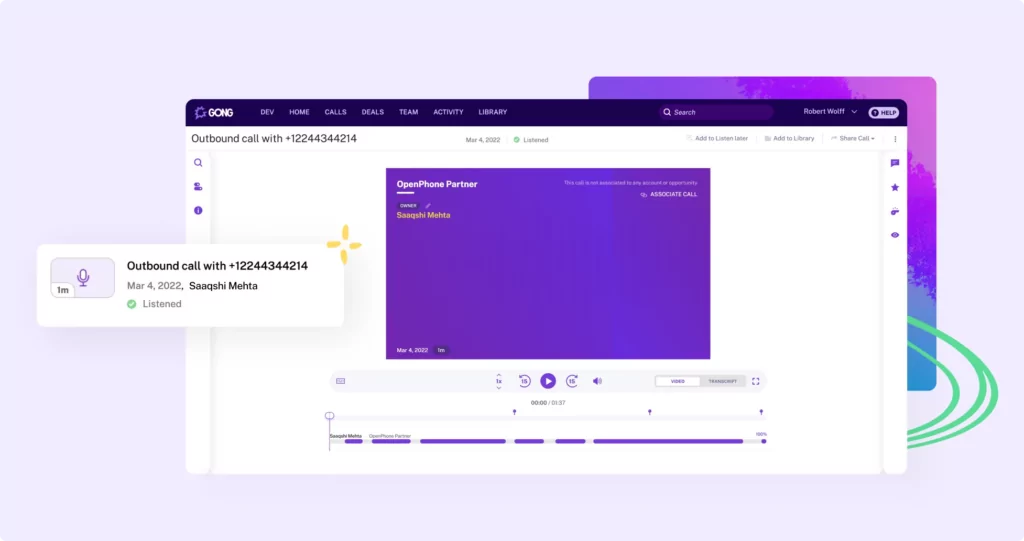
You can use OpenPhone’s integration with Gong to streamline your call review process. OpenPhone calls seamlessly sync with Gong so you can instantly review calls after they’re over. However, if you’re just delivering small business customer service as a part of a smaller team, you can use AI-generated transcripts directly in OpenPhone.
Keep in mind Gong comes with a per-user and a platform rate, depending on the size of your team. The only way to get an accurate number is to contact sales for a quote.
4. Klaus
Klaus is a conversation review and QA platform specifically designed for support teams. By using Klaus, you can identify broader trends in your interactions with customers and identify specific areas of improvement for your team.
The basic plan (Growth Suite) comes with everything you need to get started, including CSAT surveys, customer analytics, and a browser extension to review conversations from your computer. If you want more features, you can upgrade to the AI Suite to get time tracking, sentiment analysis, and performance reporting.
There’s no public pricing available for Klaus. You have to contact sales for a team-specific estimate.
5. Notifier
Want to observe what customers are saying about your business? With Notifier, you can. Notifier is a social media listening tool that lets you track mentions of key phrases that are relevant to your brand and business. You can proactively answer customer questions, monitor customer sentiment, and collect feedback for your team.
Your customers might hold back when you ask for feedback; with Notifier, you can get their unfiltered opinions and help your team improve.
Basic pricing starts at $20 per month for a max of three users and 5,000 results (per user per month). But if you want to try before you buy, there’s a free plan that offers one user and five results per month.
Get started with your customer service operations with these resources
Picking the right customer service software is vital to ensuring a successful business.
But once you’ve chosen your customer service software stack, you need the operational know-how to make your team successful.
Check out these resources to design a customer service management strategy, build a customer service team, and more:
- Customer service management strategy: 6 essentials to get you started
- Customer service training manual
- Customer service automation: a customer-centric approach
Frequently asked questions
Customer service tools aren’t just for enterprise brands. Connecting with the right tools can help you maximize your reach, maintain productivity, and look more professional to customers.
Here are three specific reasons your business needs customer service management software:
1. Improve response times: Dedicated customer service tools make small business teams more efficient — response templates and workflow automations help team members respond to customers faster. And as we know, faster response times mean better customer experiences.
2. Reduce administrative work: Like improved response times, dedicated CS tools automate the administrative work that comes with running a customer service operation. You can automatically tag and categorize service tickets, tap into metrics surrounding team performance, and assess the timeliness of the customer journey so your business can evaluate its strengths and weaknesses faster.
3. Single source of truth: Customer support teams can view customer communications in a single location. Instead of managing fragmented conversations across multiple inboxes and threads, they can rely on a single source of truth to get what they need even faster.
Businesses of all sizes should use a CRM because it helps them build customer relationships with intention from Day 1. The best CRMs are affordable and intuitive, so your team can quickly adopt them. CRMs help you track your customer relationships, from sales to customer success, so your team can offer a personalized experience during each interaction.
CRMs aren’t necessary for all customer service teams, which is why we didn’t include them in our list of customer service software tools. Communication tools like OpenPhone can function as a lightweight CRM for your business, where you can capture details about your customers and reference them in your service interactions. If you provide a service with a strong need for your customer success team to retain customers, then a CRM is right for you.
